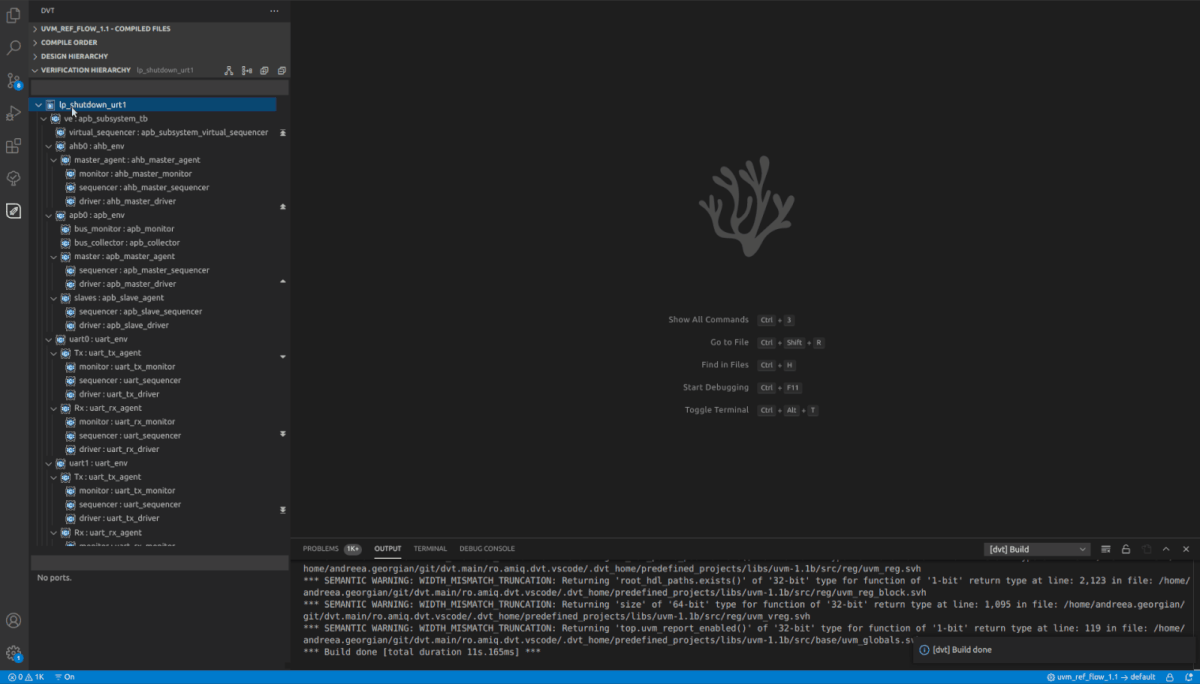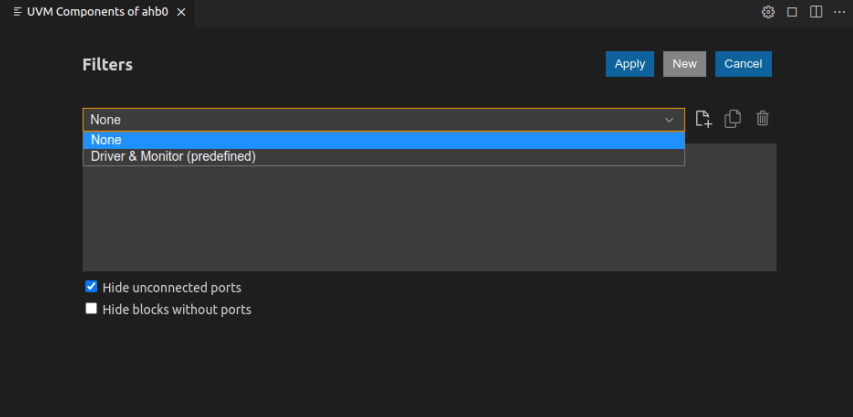UVM Components Diagrams
UVM Components Diagrams help you inspect and document the structure of a verification environment.
You can create a component diagram in one of the following ways:
Right-click in the Verification Hierarchy View and select Show Diagram. This way is faster, but the generated diagram might not be completely accurate because it’s missing the runtime information.
Generate the diagram using the simulator and open it in DVT. This way requires to run the simulation with some additional files compiled, but the generated diagram will be complete.

Component Diagrams from Verification Hierarchy
To generate the Component Diagrams from the Verification Hierarchy View, right-click on an entry in the view and select Show Diagram.
Component Diagrams from Simulation
To generate the Component Diagrams from simulation, some additional arguments must be added to the build directives, depending on the simulator.
IUS:
-f $DVT_HOME/libs/dvt_chs/dvt_chs.top.ius.f. When using-makelib/-endlibadd-f $DVT_HOME/libs/dvt_chs/dvt_chs.ius.finside the library and-top dvt_chs_moduleoutside of it.VCS:
-f $DVT_HOME/libs/dvt_chs/dvt_chs.vcs.fQuesta:
-f $DVT_HOME/libs/dvt_chs/dvt_chs.questa.f
Note
To generate diagrams for OVM environments, use the appropriate filelist from $DVT_HOME/libs/dvt_chs/ovm
When the simulation starts, a component_hierarchy_of_<test_name>.chd will be generated in the working directory. Open the generated file in DVT to inspect the diagram.
- The location of the diagram can be changed by setting the
DVT_CHS_FILEenvironment variable before running the simulation. export DVT_CHS_FILE=/path/to/a/components_diagram.chd # sh, bashsetenv DVT_CHS_FILE /path/to/a/components_diagram.chd # csh, tcsh- You can stop the test immediately after the diagram has been generated by setting the
DVT_CHS_STOP_TESTenvironment variable before running the simulation. export DVT_CHS_STOP_TEST=true # sh, bashsetenv DVT_CHS_STOP_TEST=true # csh, tcsh
Component Diagram Actions
The following operations are available in the context menu:
Go to Create Call: Jump to the create call for the selected instance.
Go to Type: Jump to the declaration of the selected element’s type. It is available for nodes and labeled edges.
Component Diagram Preferences
To see more or less information in the diagram, you can increase or decrease its depth using the preference from the toolbar.

Component Diagram Filters
You can customize the diagram using the Filters button  from the toolbar.
from the toolbar.

Use the drop-down menu at the top of the dialog to select from available filters.
Use the buttons in the top-right corner of the dialog to create, duplicate, or delete the current filter.
Use the checkboxes at the bottom of the dialog to further clean up the diagram.
A filter is defined using filter rules (one per line). The general form of a filter rule is:
command element_kinds matching regex [using color_name_or_code] command is one of hide, show, or color
element_kinds is a comma-separated list of kinds. The available kinds are instances, types, ports, port types and transaction types
regex is a regular expression that matches the relevant diagram element labels
color_name_or_code is a color specified by name, 6- or 3-digit hexadecimal code, comma-separated decimal RGB code or the keyword random. This is relevant only for color rules.
To apply a filter rule only to elements under a specific instance, you must provide the relevant path in the regex section of the rule:
a path must always begin with the name of the top instance in the diagram (if instance is under top_instance, then top_instance/instance/… is valid, while instance/… is not)
a path consists only of names of instances and “/”
each level is separated from the previous using “/” (valid: top_instance/inst1/inst2/…; not valid: top_instance.inst1.inst2…)
regular expressions may be used in the path section of a rule (for example, top_instance/.*/some_instance)
if the regex contains “/”, everything before the last “/” is the path, the rest is used to match the relevant diagram elements (in the following example, the bolded text is the path: top_instance/.*/inst1/.*drv.*)
if the regex does not contain “/”, it applies to all elements of the appropriate element_kinds
Tip
You can hide the hierarchy under an instance with the filter “hide instances matching path/to/instance/.*”.